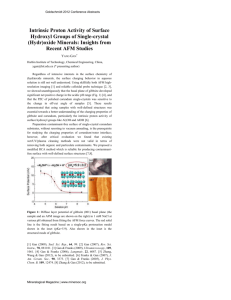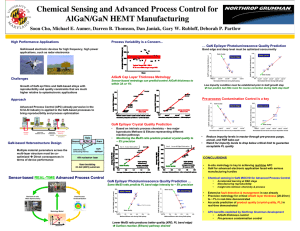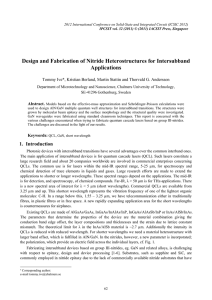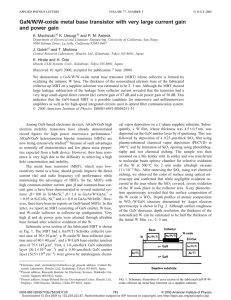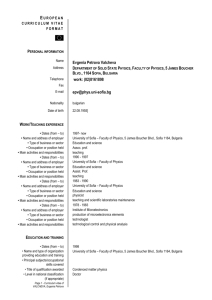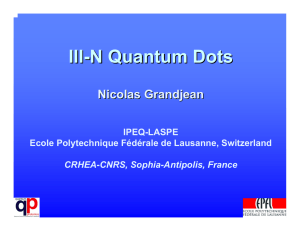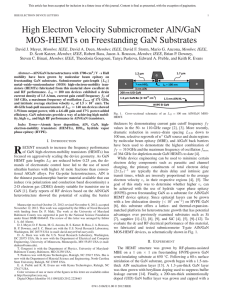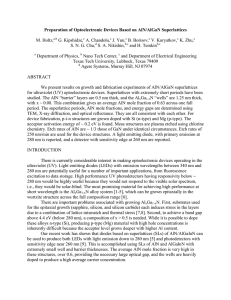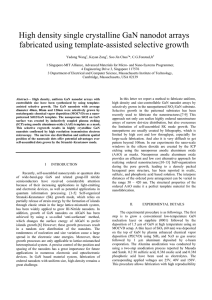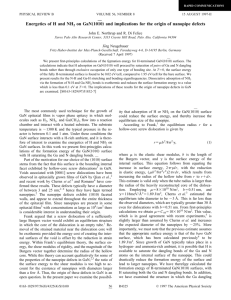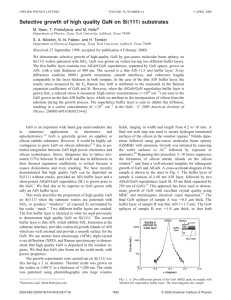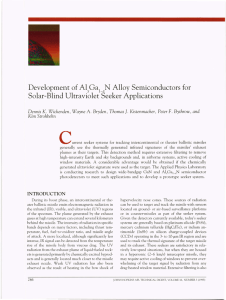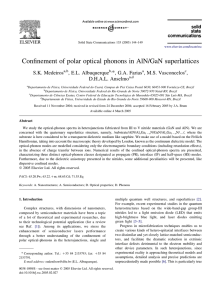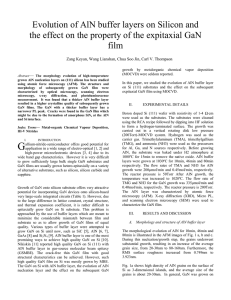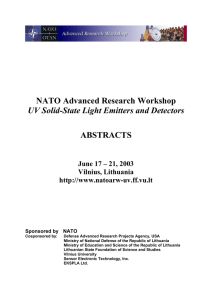Extended Abstract Template
advertisement
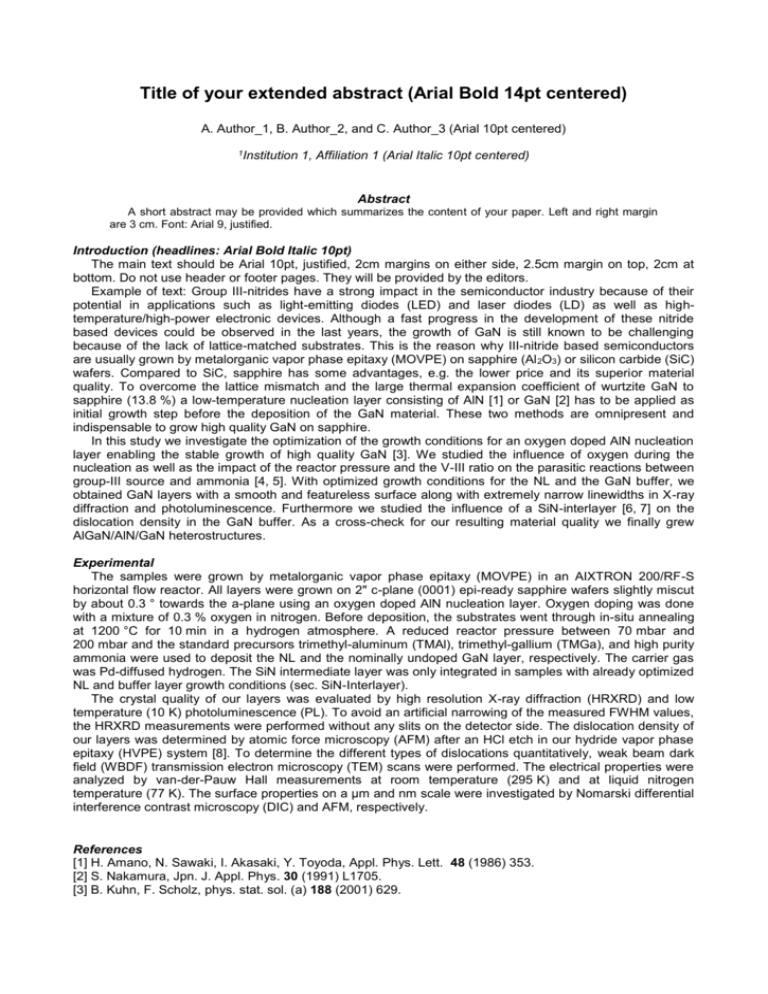
Title of your extended abstract (Arial Bold 14pt centered) A. Author_1, B. Author_2, and C. Author_3 (Arial 10pt centered) 1Institution 1, Affiliation 1 (Arial Italic 10pt centered) Abstract A short abstract may be provided which summarizes the content of your paper. Left and right margin are 3 cm. Font: Arial 9, justified. Introduction (headlines: Arial Bold Italic 10pt) The main text should be Arial 10pt, justified, 2cm margins on either side, 2.5cm margin on top, 2cm at bottom. Do not use header or footer pages. They will be provided by the editors. Example of text: Group III-nitrides have a strong impact in the semiconductor industry because of their potential in applications such as light-emitting diodes (LED) and laser diodes (LD) as well as hightemperature/high-power electronic devices. Although a fast progress in the development of these nitride based devices could be observed in the last years, the growth of GaN is still known to be challenging because of the lack of lattice-matched substrates. This is the reason why III-nitride based semiconductors are usually grown by metalorganic vapor phase epitaxy (MOVPE) on sapphire (Al 2O3) or silicon carbide (SiC) wafers. Compared to SiC, sapphire has some advantages, e.g. the lower price and its superior material quality. To overcome the lattice mismatch and the large thermal expansion coefficient of wurtzite GaN to sapphire (13.8 %) a low-temperature nucleation layer consisting of AlN [1] or GaN [2] has to be applied as initial growth step before the deposition of the GaN material. These two methods are omnipresent and indispensable to grow high quality GaN on sapphire. In this study we investigate the optimization of the growth conditions for an oxygen doped AlN nucleation layer enabling the stable growth of high quality GaN [3]. We studied the influence of oxygen during the nucleation as well as the impact of the reactor pressure and the V-III ratio on the parasitic reactions between group-III source and ammonia [4, 5]. With optimized growth conditions for the NL and the GaN buffer, we obtained GaN layers with a smooth and featureless surface along with extremely narrow linewidths in X-ray diffraction and photoluminescence. Furthermore we studied the influence of a SiN-interlayer [6, 7] on the dislocation density in the GaN buffer. As a cross-check for our resulting material quality we finally grew AlGaN/AlN/GaN heterostructures. Experimental The samples were grown by metalorganic vapor phase epitaxy (MOVPE) in an AIXTRON 200/RF-S horizontal flow reactor. All layers were grown on 2" c-plane (0001) epi-ready sapphire wafers slightly miscut by about 0.3 ° towards the a-plane using an oxygen doped AlN nucleation layer. Oxygen doping was done with a mixture of 0.3 % oxygen in nitrogen. Before deposition, the substrates went through in-situ annealing at 1200 °C for 10 min in a hydrogen atmosphere. A reduced reactor pressure between 70 mbar and 200 mbar and the standard precursors trimethyl-aluminum (TMAl), trimethyl-gallium (TMGa), and high purity ammonia were used to deposit the NL and the nominally undoped GaN layer, respectively. The carrier gas was Pd-diffused hydrogen. The SiN intermediate layer was only integrated in samples with already optimized NL and buffer layer growth conditions (sec. SiN-Interlayer). The crystal quality of our layers was evaluated by high resolution X-ray diffraction (HRXRD) and low temperature (10 K) photoluminescence (PL). To avoid an artificial narrowing of the measured FWHM values, the HRXRD measurements were performed without any slits on the detector side. The dislocation density of our layers was determined by atomic force microscopy (AFM) after an HCl etch in our hydride vapor phase epitaxy (HVPE) system [8]. To determine the different types of dislocations quantitatively, weak beam dark field (WBDF) transmission electron microscopy (TEM) scans were performed. The electrical properties were analyzed by van-der-Pauw Hall measurements at room temperature (295 K) and at liquid nitrogen temperature (77 K). The surface properties on a µm and nm scale were investigated by Nomarski differential interference contrast microscopy (DIC) and AFM, respectively. References [1] H. Amano, N. Sawaki, I. Akasaki, Y. Toyoda, Appl. Phys. Lett. 48 (1986) 353. [2] S. Nakamura, Jpn. J. Appl. Phys. 30 (1991) L1705. [3] B. Kuhn, F. Scholz, phys. stat. sol. (a) 188 (2001) 629.

![Structural and electronic properties of GaN [001] nanowires by using](http://s3.studylib.net/store/data/007592263_2-097e6f635887ae5b303613d8f900ab21-300x300.png)



